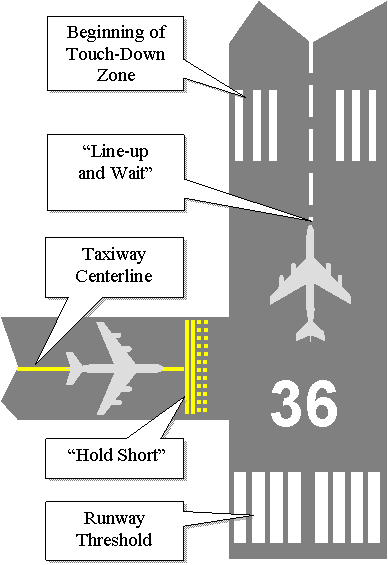|
Copyright ©2011 by Paul Niquette All rights reserved. |
||||||
There is one exception."Hold short" may be the only absolute mandate in aviation -- the only utterance by ATC -- that must be obeyed by the PIC. Hey, the plane is, after all, sitting safely on the ground. Of course, ATC and the PIC are collaborators in assuring safety. That has not always been true, but today, as a practical matter, the PIC will negotiate with ATC to resolve clearance issues -- in flight. On the ground, though, ATC's "hold short" holds primacy.
Solvers have been given three cases... Case {1} Waiting to allow time for an aircraft taking off or landing on a crossing runway to clear the intersection, The "wait" begins, when an aircraft "holding short" receives the "line up and wait" (LUAW) clearance from the tower controller. The PIC must release the brakes, apply power for a slow taxi onto the runway centerline, straighten the nosewheel, return power to idle, and apply the brakes. A reasonable estimate for all those actions might total 30 seconds. The duration of the "wait" can be some amount of additional time depending on various events and conditions, including controller work-load. FAA guidelines suggest, "If a takeoff clearance is not received within a reasonable amount of time after clearance to line up and wait, ATC should be contacted." Ya think?Permission to enter the active runway with a LUAW clearance depends on which of the three cases is applicable. There is no need to delay that clearance in Case {1}; all the action is taking place on a runway typically a mile away. Likewise for Case {2}. Having received the LUAW, the PIC in the aircraft at the hold line can make first-hand judgments about the preceeding aircraft and allow room to avoid its takeoff thrust before "lining up" on the runway.
If the aircraft waiting on the runway is "cleared for takeoff" but for any reason is unable to comply with requisite promptness, an approaching aircraft must be told, "Go-around!" -- generally followed by, "Do not acknowledge, go around!"There are situations -- low fuel reserves, say, coupled with prolonged "missed-approach" intervals -- that may require the PIC to decline a "go-around" and elect to continue inbound and be forced to touch-down beyond the waiting aircraft. The maneuver is dangerous but not unknown. It actually has a name in the parlance of light aircraft, "land-over."
Sophisticated solvers of the Position
and Hold puzzle
may enjoy studying the logistical
properties of a dozen airport layouts to ascertain the
role of runway /
taxiway configurations and to consider the locations
of terminals / concourses
in estimating the true value of LUAW...
One hears that a half-minute can make a substantial difference in runway capacity. That may not be likely for Case {1}. But for Case {2}, wherein takeoffs and landings are presumed to be taking place on non-intersecting runways LUAW deserves consideration. For analysis of Case {2}, let us make a couple of assumptions: that in the 'terminal area' airliners typically fly at 180 mph and must be separated by at least three miles from one another. Thus, on any common pathway in the sky, either approaching or departing the airport, airliners would follow one another by about a minute (180 / 3). In transportation industries, that's called headway, referring to the time between successive trains or buses or -- well, airliners. Headway is constant everywhere, like current in an electrical circuit. Separation in distance, though, varies with speed. In Case {2}, it is easy to show
that on the runway
handling departures, successive takeoffs must have a
headway of one full
minute to assure a three-mile separation if there is a
common departure
path in the sky. Indeed routine procedures
generally assign a common
initial fix to successive departures, with divergences
enabled beyond.
Accordingly, the "line up and wait" clearance -- even
in Case {2}
-- may not often realize a beneficial effect on runway
capacity.
|
 The
The